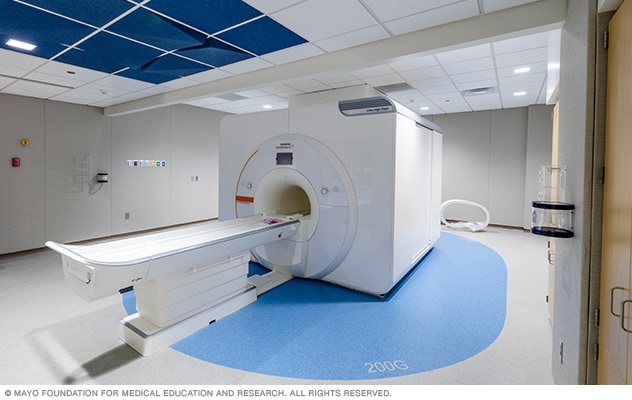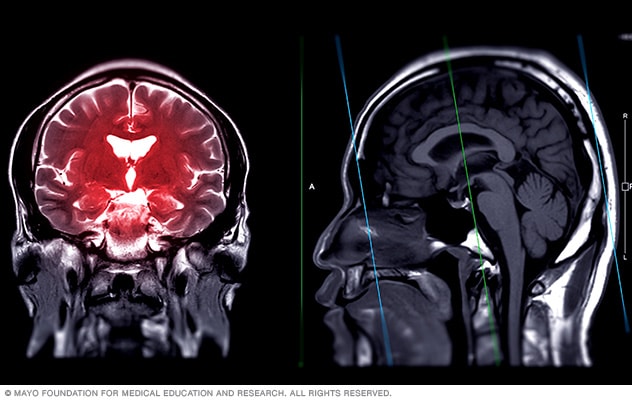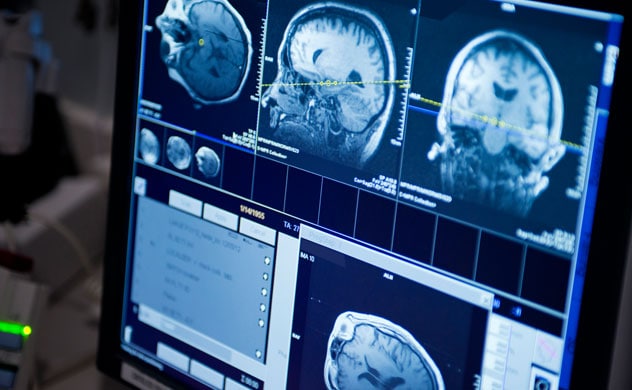نظرة عامة
Brain magnetic resonance imaging, also called brain MRI, is a diagnostic test that provides detailed images of the brain. A brain MRI also can take images of the neck and spine. Each image represents a separate section or slice of the brain. A brain MRI also may be called a head MRI or cranial MRI.
During the test, you lie in a long, tube-shaped machine that scans your head while a computer takes pictures and creates images of the inside of your brain. It creates images as slices of the inside of your brain — similar to slices of bread.
A brain MRI scanner, also called a brain MRI machine, uses a computer, radio waves and a very strong magnet to take these detailed pictures. This test doesn't cause pain. But it does make a loud noise, and some machines involve being in an enclosed space. These things may not be comfortable for some people. A brain MRI doesn't use radiation and is considered very safe for most people.
You may need a brain MRI for many different reasons. A brain MRI can show a healthcare professional any areas of the brain where changes have occurred or where the brain isn't functioning as it should. This test may be used to diagnose the cause of symptoms such as headaches, changes in vision, seizures or hearing loss. Some of the conditions that may be diagnosed through MRI include stroke, tumors and multiple sclerosis.
Types of brain MRI scanners
7-tesla MRI machine

7-tesla MRI machine
The 7-tesla machine uses the heaviest, and therefore strongest, magnet. The stronger the magnet, the greater the detail on the images.
There are several types of MRI scanners, also called MRI machines:
- Closed-bore MRI, also called traditional MRI. This machine has an open center, called a bore, in which you lie on a table while the machine takes images. This type of MRI machine takes the clearest and most detailed images.
- Wide-bore MRI machine. This MRI machine has a wider center opening than that of the traditional MRI. A magnet still surrounds you on all sides, but there is more room inside. These machines may be more comfortable for someone who has a larger body size or who is afraid of enclosed spaces.
- Open-bore MRI. This MRI machine does not fully enclose you. The magnets are placed above and below, but not on the sides. It's more comfortable for people with larger bodies and those who are afraid of enclosed spaces.
- Upright MRI, also called standing or sitting MRI. This machine allows you to lie down, stand or sit while the images are captured. In this test, you wear a head coil that fits like a helmet. The coil receives the radio waves and creates the image of your brain. Upright MRI was designed to help people be more comfortable during the test. It also provides images of how your brain looks in different positions.
Besides the scanner type, another way that MRIs can be categorized is by magnet strength. The unit of measurement that indicates the magnet strength is called tesla, which can be shortened to T. These magnet strengths include 1.5 tesla, 3 tesla and 7 tesla. The higher the number, the greater the strength of the magnet — and the greater the detail in the images. Any type of MRI machine — closed bore, wide bore, open bore and upright bore — can use a magnet of any strength.
Sometimes, brain MRI may be done using a special dye called contrast or contrast agent. The contrast is injected into a vein before the test. Contrast brain MRI is used if the healthcare professional needs to highlight certain tissues within the brain. The contrast helps provide a clearer image of the brain structure.
The most common contrast agents used for brain MRI contain a substance called gadolinium. Some people may be allergic to gadolinium and may not be able to have brain MRI with contrast. People with kidney disease may not be able to have some types of gadolinium contrast agents.
You may need a functional MRI, also called fMRI. A functional brain MRI uses the same machine and process as a traditional MRI. But the person giving the fMRI may ask you to do certain things, such as move your arm or perform mental exercises such as a simple math problem.
This test captures the activity and blood flow in the brain during these activities, not just the structure. For example, you may need a functional MRI before brain surgery to help locate the areas in your brain that control speech or memory. In a functional MRI, the areas of the brain where there is more blood flow and activity appear brighter on the computer screen.
لماذا يتم ذلك؟
Brain MRI is done to test for a number of different conditions, and to figure out the cause of a variety of symptoms.
A healthcare professional may suggest a brain MRI to figure out the cause of symptoms including:
- Being unable to move part of the body.
- Dizziness.
- Headaches.
- Hearing problems.
- Problems speaking.
- Seizures.
- Symptoms after a head injury.
- Vision problems, such as losing sight or seeing double.
Brain MRI may be used to diagnose health conditions such as:
- Bleeding in the brain.
- Brain aneurysm.
- Brain trauma.
- Brain tumors.
- Blood clots in the brain.
- Dementia.
- Epilepsy.
- Fluid on the brain, also called hydrocephalus.
- Issues with the pituitary gland.
- Memory loss.
- Migraines and headaches.
- Movement disorders.
- Multiple sclerosis.
- Spinal cord injury.
- Stroke.
Brain MRI may be used for reasons other than diagnosing a particular condition. Other reasons you may need a brain MRI include:
- Brain mapping. Before having brain surgery, your healthcare professional may need to do a brain MRI to locate certain areas of the brain. The health professional may look for which areas control movement, speech and memory so a surgeon can be careful to avoid these areas during surgery. Brain mapping also may be done before radiation therapy to the brain.
- Looking for changes in the brain. If you've already been diagnosed with a brain tumor or other condition, you may need additional brain MRIs. These scans can determine whether the tumor is growing. As people get older, they may need brain MRIs to look for shrinking of the brain.
- Monitoring. Certain treatments, such as new treatments for Alzheimer's disease, require monitoring with brain MRI scans to determine safety and efficacy.
Your healthcare professional may suggest a brain MRI over other types of brain imaging tests, such as CT scans, because brain MRI shows greater detail and differences between brain tissues. Also, brain MRI may be preferred over CT for someone who can't be exposed to radiation.
المخاطر
Brain MRI is generally a very safe test without major risks. But certain factors can increase the risk of issues during brain MRI.
Metal items in or on the body
Because the MRI machine uses a large, powerful magnet, people with metal on or in their bodies may need extra care. Items that may have metal include:
- Pacemakers or any of their parts.
- Implantable heart defibrillators.
- Pins or screws.
- Surgical staples.
- Stents.
- Stimulation devices, such as deep brain stimulators.
- Hearing aids or implants in the ear.
- Clips or coils to treat an aneurysm.
- Continuous glucose monitoring systems.
- Devices implanted in the body to deliver medicines, such as insulin.
- Devices used to expand tissues.
- Pieces of shrapnel or bullets.
- Any implant with a magnet or metal.
- Body piercings, tattoos, permanent eyeliner or other permanent cosmetics.
- Prosthetic joints.
- Artificial heart valves.
The magnet in the MRI machine may pull these metal objects, causing injury. The metal objects may fly across the room as they are pulled by the strong magnetic field. The magnet in the MRI also may cause the metal objects in the body to heat up and cause burns. Talk with your healthcare professional before your brain MRI to discuss any items that may affect your safety during the procedure.
If you who have obesity or are afraid of enclosed spaces, you may have a very hard time being comfortable during a brain MRI. Ask your care team about ways to make brain MRI easier for you.
Kidney disease and brain MRI with contrast
If you are having a brain MRI with contrast and you have kidney disease, your healthcare professional will talk to you about the type of contrast you can have. The newer types of gadolinium contrast are typically safe, but older gadolinium contrast agents may not be recommended for you. You may be at greater risk of a rare but serious disease called nephrogenic systemic fibrosis. This can cause thickening of the organs, skin and other tissues. Rarely, it may cause death.
If you are having a brain MRI with contrast, it's possible to have an allergic reaction to the contrast agent. This may cause itchiness and hives. Some people have an upset stomach or other discomfort from the contrast.
كيف تستعد؟
You and your healthcare professional discuss what you should do to prepare for your brain MRI. You can usually eat and drink without restrictions before having a brain MRI. Ask your healthcare professional if you have questions about specific food or drink, such as caffeinated or alcoholic drinks. You should be able to take all of your daily medicines unless your healthcare professional tells you not to.
You can wear whatever clothing you'd like to for a brain MRI because you change into a gown for the test. You should take care getting ready that day and avoid wearing:
- Makeup with any metallic particles.
- Jewelry and watches.
- Pins or accessories for your hair made of metal.
- Eyeglasses.
- Dentures and other dental pieces with metal that you can remove.
- Body piercings.
- Hearing aids.
- A bra with an underwire.
Usually, most cosmetics, dental fillings and braces do not cause issues with a brain MRI. It's possible they may make the images a little less clear. Talk with your healthcare professional if you have any questions or concerns.
In general, it isn't recommended that people who are pregnant have a brain MRI in the first trimester unless not having the test poses a significant risk. Brain MRI is usually considered safe during the later months of pregnancy. While there is no radiation, the fetus will be around the strong magnetic field of the machine. Pregnant women should not have brain MRI with contrast at any time during pregnancy. Always tell your healthcare professional if you are or may be pregnant.
Do not take a cellphone, credit cards or other magnetic objects into the room with you for the brain MRI. These items can affect the clarity of the images, and the magnet may ruin these items.
Because the MRI machine can be very loud during the test, you’ll need to wear hearing protection. You may want to bring a pair of earplugs to keep you calm and comfortable. In some facilities, the care team may give you some to wear.
ما يمكن أن تتوقعه
Before brain MRI
MRI scanner room and viewing room

MRI scanner room and viewing room
The MRI scanner is in a separate room from the technicians who operate the machine and capture the images of your brain. You can communicate between the rooms through a speaker.
Before your brain MRI, discuss questions and any steps you should take to prepare with your healthcare professional. You change into a hospital gown or scrubs for your brain MRI once you are at the facility. Follow your healthcare professional's instructions about metal objects before you go into the room for your brain MRI.
If you are not sure or have questions about any metal objects in your body, you may have an X-ray to confirm that it's safe to have the brain MRI. If you are nervous or anxious about having the test and being in a tight space, your healthcare professional may offer you medicine that helps you feel relaxed. However, you need to be awake during the MRI.
If you have a friend or family member in the room with you during the brain MRI, that person also has to follow instructions about metal objects.
During brain MRI
Once you're in the exam room, you're asked to lie flat on your back on a long table. The table slides in and out of the MRI machine. A traditional MRI machine looks like a big, hollow cylinder or tube with space in the middle for the table. The machine around you contains the magnet.
If you're having an open MRI, wide-bore MRI or upright MRI, your position may be different. Depending on the type of MRI machine used, the magnet may not completely surround you. You may be standing or sitting. Your care team tells you how to position your body for the MRI.
You may have your arms and legs strapped into place so that you stay very still during the test. The care team doing the test places a brain MRI coil around your head. This is similar to a helmet and helps provide clearer and more detailed pictures of your brain.
If you are having a brain MRI with contrast, the healthcare professional places a small needle with a tube on it into a vein in your hand or arm. The health professional injects the contrast into the tube, called an IV, in your vein. The contrast may make you feel a cold sensation or flushing in your cheeks.
The table slides into the MRI machine, and you are in the center of the magnet. The healthcare professional giving the test is in a different room. But there is an intercom system so that you can hear and talk with each other during the entire test.
As you lie on the table, you may hear loud clanging, pounding or banging sounds. You may be asked to hold your breath at times during the test to help get the clearest picture. You may notice a warm feeling on your head during the test. If you are uncomfortable, tell the healthcare professional through the intercom.
The brain MRI usually lasts between 30 and 60 minutes.
Sometimes, you may have a brain MRI during surgery. This may be done to help guide surgeons as they remove a tumor or perform other procedures for which they need images of the brain. This is called intraoperative MRI, also known as iMRI.
How brain MRI works
MRI brain scan T-weighted images

MRI brain scan T-weighted images
T2-weighted and T1-weighted brain magnetic resonance imaging (MRI) scans. These images can help diagnose brain conditions such as tumors, multiple sclerosis and stroke.
The machine sends radiofrequency waves into your body. The patterns of the radiofrequency waves and pulses produced by the MRI machine are called sequences. Each sequence provides a slightly different version of how the image is produced — for instance, a slightly different shading or resolution. Some of the different types of sequences used in brain MRI include:
- T-1 weighted with gadolinium
- T-1 weighted without gadolinium
- T-2 weighted
- Perfusion MRI
- Diffusion-weighted MRI
- Fluid-attenuated inversion recovery, also called FLAIR.
The radiofrequency waves "excite" the hydrogen atoms in the body and make them line up. As the hydrogen atoms return to their usual places, they release energy. The amount of energy they release is different for each type of tissue the hydrogen atoms are in. The computer part of the brain MRI machine measures this energy and uses the information to create pictures of the brain.
The T in these sequences relates to the relaxation time. Relaxation time is the length of time it takes for the hydrogen atoms to "relax," which means return to their usual places.
After brain MRI
تصوير بالرنين المغناطيسي لورم بالدماغ

تصوير بالرنين المغناطيسي لورم بالدماغ
تصوير لورم الدماغ
Once members of your healthcare team have confirmed that they have the images they need of your brain, they return to the exam room to help you out of the machine. If you had a brain MRI with contrast, they remove the IV from your vein and cover the area with a small bandage. You may have a little discomfort or some bruising where you had the IV.
You don't need recovery time after a brain MRI. But if you took medicine to help you relax, you may need to wait a bit for it to wear off before you get dressed and go home.
If you have not taken medicine to help you relax, you should be able to drive yourself home after your brain MRI. You can go back to your usual daily activities and diet right after the brain MRI.
النتائج
After your brain MRI is finished, a healthcare professional, usually a radiologist, reads the results. A radiologist is a specialist trained in reading imaging test results. The healthcare professional who ordered the brain MRI for you gets the report and discusses it with you.
Your healthcare professional lets you know if everything looks healthy in your brain or if there are any areas of concern. Any findings that are not typical may mean that you need an additional brain MRI, other imaging test or other diagnostic tests. Or your healthcare professional may want to watch and wait to see if there are any changes over time.
If members of your healthcare team are able to diagnose the cause of your symptoms, they will likely talk to you about your treatment plan and next steps.